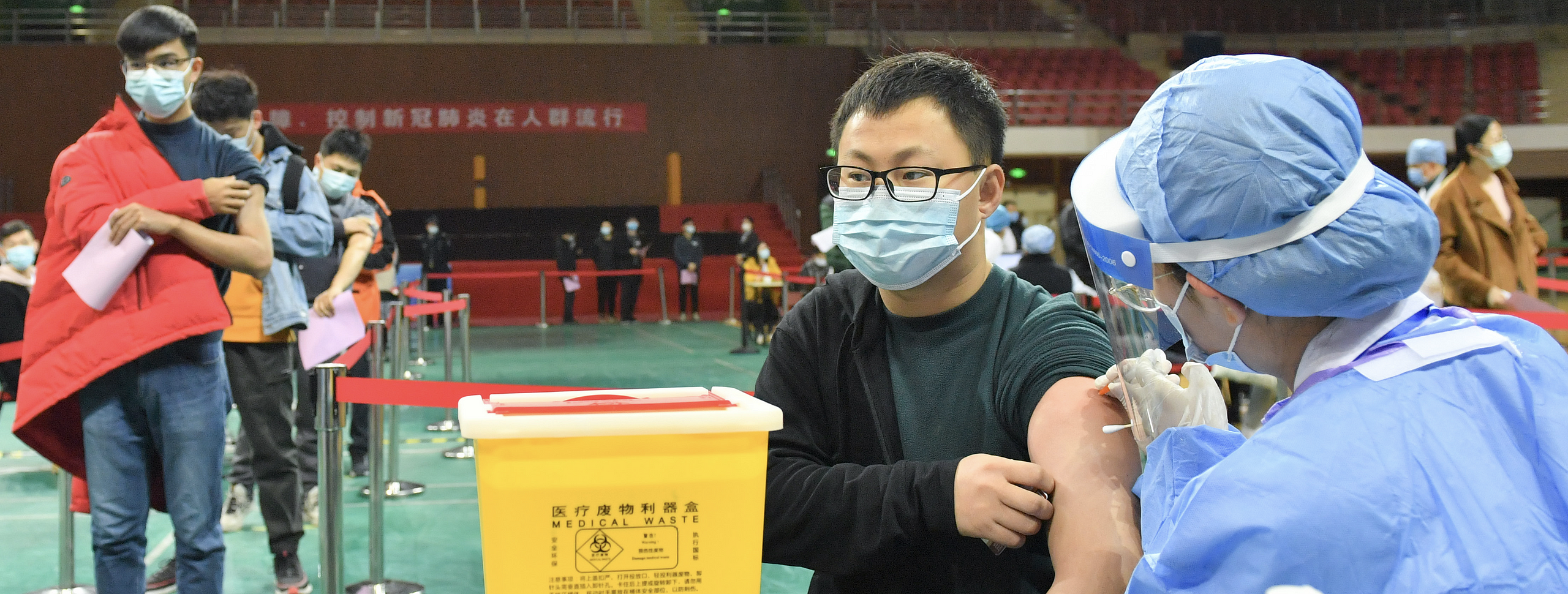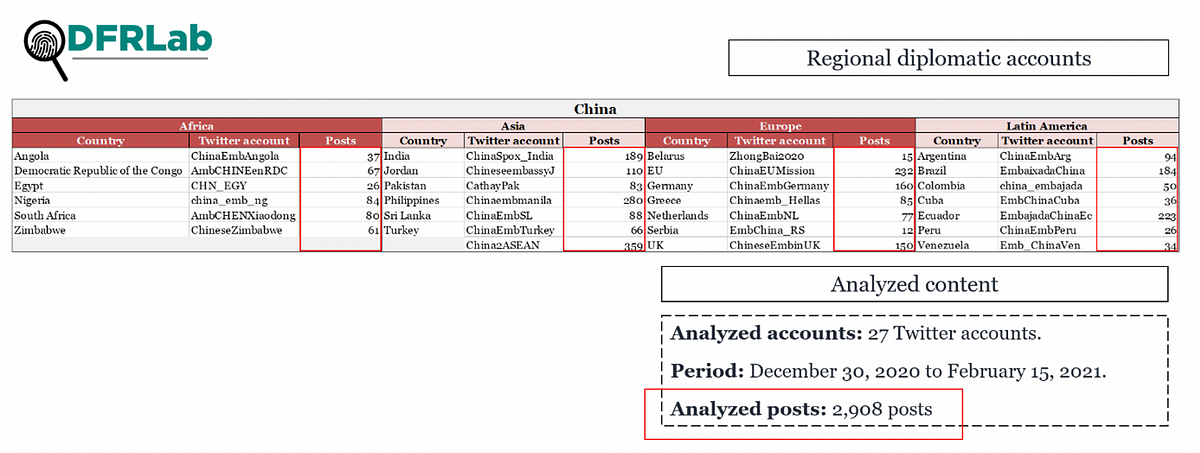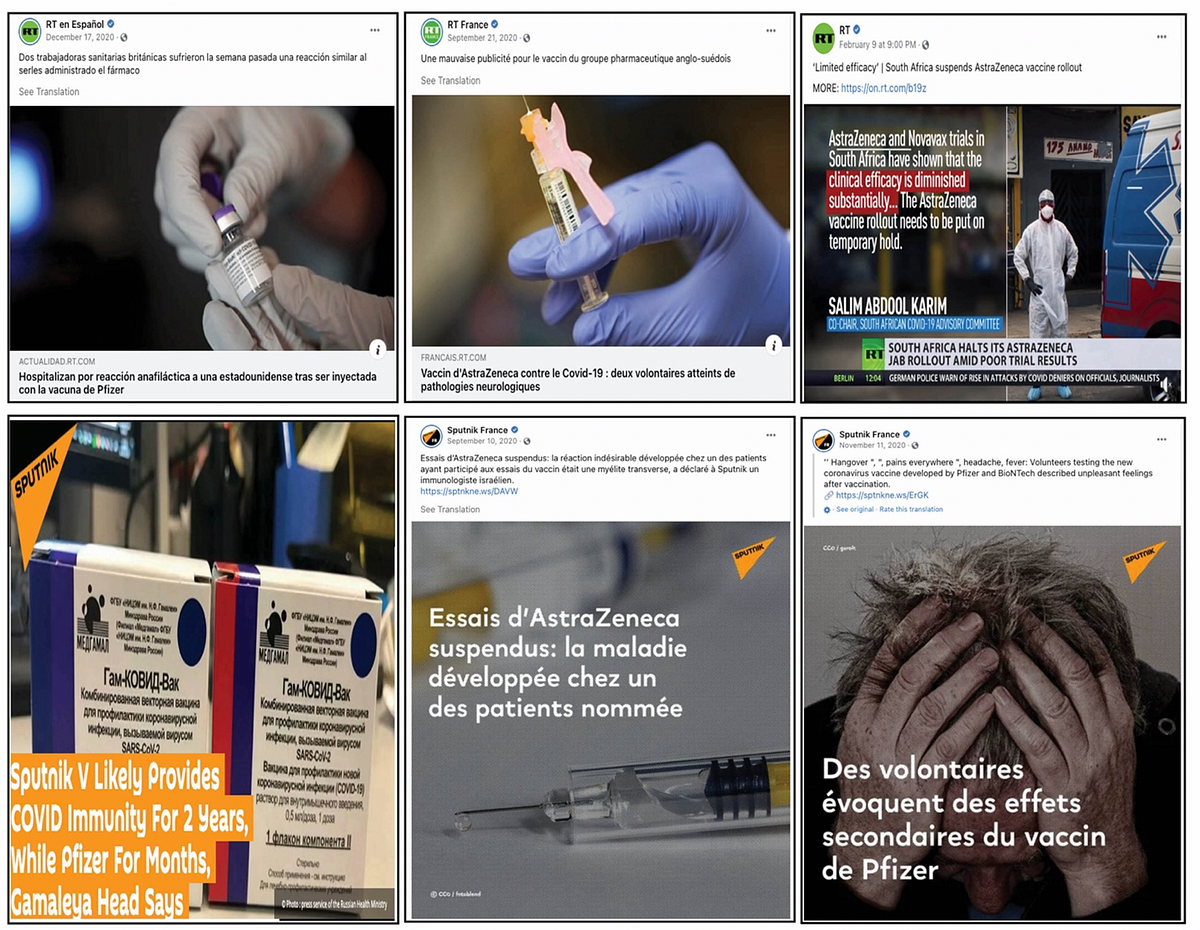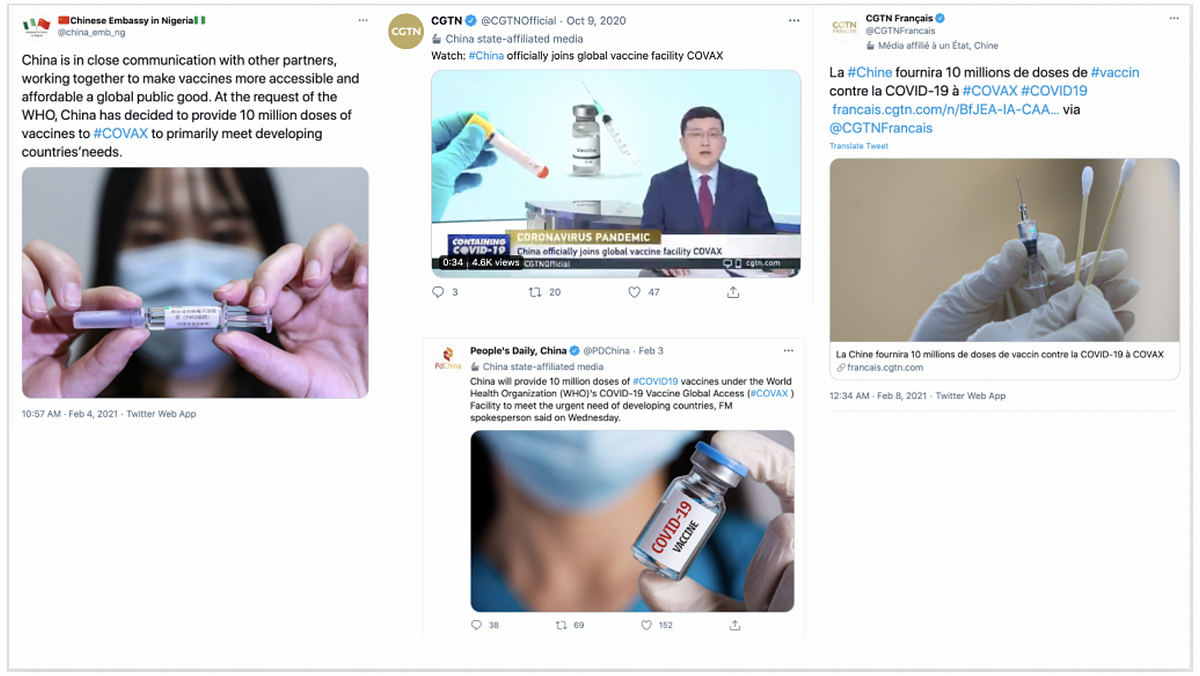Kremlin-linked social media accounts promoted Sputnik V mostly in Latin America, while China targeted Asian countries

By Givi Gigitashvili and Esteban Ponce de León
Amid the ongoing race to dominate the COVID-19 vaccine uptake, Russia and China have been actively promoting their respective vaccines abroad through state-funded outlets and diplomatic accounts. The DFRLab found that, while Kremlin-funded Russian media outlets put forward negative narratives about Western vaccines in an attempt to undermine trust, Chinese state-backed media outlets have focused more on promoting the positive image of the country’s own vaccines as well as its role as a benevolent leader combatting COVID-19 internationally.
Asserting themselves as global powers, China and Russia have attempted to launch a new diplomatic campaign by offering their vaccines to other countries around the globe, especially developing countries in Asia, Eurasia, Latin America, and Africa. This can be seen as part of their efforts to boost their international standing. More importantly, through promoting and exporting their vaccines to other countries, China and Russia are able to expand their geopolitical and economic influence. The DFRLab investigation showed that, while Russia has mainly targeted Latin American countries and used positive phrasing of its vaccines while attacking Western vaccines, China relies more on cheerleading narratives with a geopolitical focus on Asian countries.
Methodology
Using Twitter’s free API and the social media listening tool CrowdTangle, the DFRLab analyzed 16 Chinese and 10 Russian state-backed media outlets that publish content in English, Spanish, and French. Along with those media outlets, this article also covers 28 diplomatic Twitter accounts (embassies, embassy spokespeople, and ambassadors) operated by China and Russia across four continents: Latin America, Europe, Asia, and Africa. Diplomatic accounts were selected based the perceived strength of Russia or China’s respective economic and trade ties to the country as well as military and political cooperation. Moreover, sampling for this analysis included countries that have bought the vaccines from China or Russia as well as countries that have not bought vaccines yet. In total, the DFRLab analyzed more than 200,000 Twitter posts published by 90 accounts, including both state-backed media outlets and the diplomatic accounts. The following tables show the distribution of these posts per account, region, and country.


Apart from the diplomatic accounts, the DFRLab also selected Russian and Chinese state-backed media outlets. The DFRLab analyzed Twitter and Facebook posts starting from August 11, 2020 in the case of Russia, and December 30, 2020 for China, both dates selected based off of when they first approved their respective vaccines.

The DFRLab subsequently selected Russian and Chinese-related vaccine hashtags and keywords and identified their use in Twitter and Facebook posts by state-backed media outlets and diplomatic accounts. The following table shows the selected keywords.

Russia’s negative coverage of Western vaccines
While Russian state-backed international media outlets and diplomatic accounts on Twitter posted mostly positive coverage of Sputnik V, they also pushed negative coverage of Western vaccines in an apparent effort to undermine public trust in Western-made vaccines and to convince the broader public that the Russian vaccine was more effective than Western vaccines. According to the Sputnik V website, the efficacy of the Sputnik V is 91.4 percent, which is higher than that of AstraZeneca’s vaccine (70.4 percent after two full doses) but lower than both Pfizer and Moderna after the second doses, which are estimated at 95 and 94.1 percent efficacy rate, respectively.
Some of the unsubstantiated claims in their reporting were related to supposed dangerous side effects of the AstraZeneca and Pfizer vaccines. RT and Sputnik claimed, for instance, that the vaccines cause psychological and neurological disorders and that Western vaccines had only a limited positive effect. Sputnik also amplified stories linking Pfizer vaccine to deaths of individuals, without providing additional details as to whether death was truly caused by vaccination or not. As the DFRLab has previously reported, such negative claims about Western vaccines made by Russian outlets are frequently amplified by anti-vaccination groups.

The DFRLab investigation showed that positive content about the Russian vaccine Sputnik V overwhelmed negative content targeting Western vaccines. It appears that Russia’s diplomatic accounts put a particular emphasis on targeting the Latin American market. An analysis of 31 Russian diplomatic accounts showed that those for Russian diplomats or embassies in Latin American countries have been the most active in terms of promoting Sputnik V, as these accounts mentioned hashtags and keywords related to the Russian vaccine more frequently than the total mentions by diplomatic accounts on the three other continents.
A timeline of mentions of the selected hashtags and keywords shows that diplomatic accounts in Latin America started to promote Sputnik V much earlier than on other continents. Promotion of Sputnik V started almost simultaneously in Africa and in Europe.

Tweets mentioning these hashtags and keywords garnered around half a million engagements in Latin America, while content posted by Russian diplomatic accounts in Europe garnered the smallest amount of engagement. Latin America has been among the regions hit the worst by the COVID-19 pandemic, and six countries in Latin America had already authorized and purchased the Russian vaccine as of February 4, 2021.

Russian state-backed media outlets in Latin America, including the Spanish-language editions of RT and Sputnik, started posting content on the Sputnik V and its efficacy before August 11, 2020, when Russia first officially approved it for use.

Based on content published by both Russia-linked diplomatic accounts and state-backed media outlets in Latin America, the DFRLab created a network graph of co-occurring keywords included in their Twitter posts. This technique allowed researchers to identify recurrent connections among keywords in the text. The results showed that, during the analysis period between August 11, 2020, and February 12, 2021, such diplomatic accounts and media outlets mostly included keywords such as “Sputnik V” and “Vacuna Rusa” (“Russian Vaccine”).
According to this analysis, countries such as Argentina, Mexico, and Venezuela were among the most connected keywords as well. Argentina approved Sputnik V on December 23, 2020, for people over 60, after the country ran at least eight clinical trials for different vaccines, one of which was Sputnik V. Mexico also authorized Sputnik V for emergency use on February 2, 2021, after signing a contract for 24 million doses, of which Mexico expects 7.4 million doses between February and April. Venezuela, on the other hand, received the first 100,000 doses of the Russian vaccine on February 13. Venezuela had authorized Sputnik V for use on January 13, 2021.

Like the diplomatic accounts, Russian state-backed media outlets also included similar keywords on their Twitter posts, such as “Sputnik V” and “Russian vaccine.”

The DFRLab also compared the performance of Russian state-backed media outlets on Twitter and Facebook and, even though Spanish-language content was leading in terms of mentioning Sputnik V-related hashtags and keywords on Twitter, Russian state-funded media outlets used Sputnik V-related hashtags and keywords more frequently in French on Facebook. Mentions in English garnered the smallest amount of mentions on both Twitter and Facebook.

The DFRLab also analyzed mentions of Western vaccines on Twitter and Facebook by Russian media outlets and found that Pfizer was mentioned most frequently by those outlets in all three languages followed by mentions of AstraZeneca. Moderna garnered the least amount of mentions.

Chinese vaccine-related narratives
Chinese state media and diplomatic accounts did not seem to invest much effort in propagating false narratives to discredit Western vaccines in the eyes of their foreign readers on social media. Instead, the DFRLab’s investigation revealed a batch of social media accounts belonging to Chinese state media and diplomatic accounts on Facebook and Twitter that focused on promoting China’s own vaccines and demonstrating the country’s dedication to leading the efforts of distributing the vaccines to developing countries, especially in Asia.
An analysis of 28 Chinese diplomatic accounts on Twitter revealed that the accounts received a high volume of engagements in both Asian and South American countries. The two graphs below show that these diplomatic accounts post most actively in Asian countries with hashtags and keywords related to Chinese COVID-19 vaccines, while the mentions of the same set of hashtags in Africa, Europe, and South America are around the same volume. Despite the relatively inactive posting of diplomatic accounts in Latin American countries, their posts nevertheless received high engagement. Therefore, it shows that Chinese diplomatic accounts emphasized its vaccine campaign in Asian countries but received high engagements in Latin American countries.

The most posted keywords by Chinese diplomatic accounts are SinoVac, SinoPharm, and COVAX, indicative of China’s overall strategy of promoting its vaccines as well as its ambition of being an international leader of COVID-19 vaccine providers. SinoVac and SinoPharm are two Chinese biopharmaceutical companies that have developed COVID-19 vaccines. COVAX is a global vaccine initiative that seeks equitable distribution of COVID-19 vaccines around the world under the leadership of the Global Alliance for Vaccines and Immunization, the World Health Organization, and the Coalition for Epidemic Preparedness Innovations. China has joined the initiative in October 2020.
The frequent posting of SinoVac and SinoPharm consistently reminded the accounts’ followers of the recent positive updates of Chinese vaccines, including delivery of Chinese vaccines to other countries, efficacy test of the Chinese vaccines, and its dedication to the COVAX initiative, therefore instilling a perception of the reliability and the affordability of Chinese vaccines.

The frequent mention of COVAX demonstrates that the diplomatic service not only promotes Chinese vaccines but also pushes positive messaging around China’s leadership in meeting the vaccination needs of developing nations during the pandemic. On one hand, the diplomatic accounts’ constant posts of SinoVac and SinoPharm give its followers regular exposure to information that extols the high quality of Chinese vaccines. On the other hand, the regular mention of COVAX, as a global initiative, aims to shape perceptions of China as a caring global leader that provides affordable and effective vaccines to developing nations. This attempt to shape global perceptions of China clearly aligns with the country’s discourse power philosophy, as discussed at length by a previous DFRLab report.

Similar analysis of Chinese state media accounts on Twitter and Facebook further demonstrated that content related to vaccines posted in English appeared more often than their counterparts in French or Spanish and, accordingly, received higher number of interactions. The number of posts in English by state-controlled media on both Twitter and Facebook far exceeded that in French and Spanish, and so did the interactions. The number of posts related to vaccines in French and in Spanish as well as their engagements/interactions were of a comparable volume.

Additionally, the DFRLab’s investigation also found that narratives about Western vaccines, especially in the form of disinformation, have not been as much of a focus of Chinese diplomatic accounts and state media accounts on both Twitter and Facebook, compared to Russia. Diplomatic accounts post minimally about these Western vaccines, probably because out of its primary purpose of focusing on building China-related narratives.


China and Russia maintain different agendas toward Western vaccines: while Russia seeks to portray them in a negative light, Chinese state-backed outlets do it less frequently. Yet the two countries are similar in terms of prioritizing the promotion of their own vaccines, despite a slight deviation of the campaign’s geographical focus. Both countries seeks to not only shape the international reputation of their vaccines but also to accentuate their roles as world leaders in providing developing countries access to their vaccines. It seems that China and Russia focus on different regions: while Russia actively promotes its vaccine in Latin America, China is more active in Asia in terms of promoting its vaccine.
Givi Gigitashvili is Research Assistant, Caucasus, with the Digital Forensic Research Lab and is based in Georgia.
Esteban Ponce de León is a Research Assistant, Latin America, with the Digital Forensic Research Lab.
Cite this source:
Givi Gigitashvili and Esteban Ponce de León, “Russia and China employ state-funded media and diplomatic Twitter accounts in global vaccine race,” Digital Forensic Research Lab (DFRLab), March 25, 2021, https://medium.com/dfrlab/russia-and-china-employ-state-funded-media-and-diplomatic-twitter-accounts-in-global-vaccine-race-f51c53cf3e8c.

